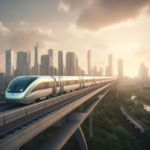The Evolution of Business Parks: From Corporate Hubs to Sustainable Communities
Outline
- Introduction
- The Emergence of Business Parks: A Post-War Phenomenon
- Peak Popularity: The Golden Era of Business Parks
- The Digital Revolution and the Decline of Traditional Business Parks
- Adapting to New Realities: The Future of Business Parks
- Sustainability: The Driving Force Behind Modern Developments
- The Global Impact of Changing Business Park Models
- Conclusion
- Frequently Asked Questions
- Get in Touch
Introduction: The Evolution of Business Parks
Business parks have long been symbols of corporate power and economic growth, offering vast spaces dedicated to office buildings, industrial facilities, and research centers. Emerging in the mid-20th century, these parks represented a shift in how companies operated, providing large, organized areas where businesses could collaborate and thrive. However, as urban landscapes continue to evolve, the traditional business park model faces growing challenges. The rise of new technologies, shifts in work culture, and the growing importance of sustainability are changing how we think about these sprawling corporate hubs.
In this article, we will explore the historical rise of business parks, the factors contributing to their decline, and how the concept might adapt to meet the needs of the future. We will also examine the impact of the digital economy and how modern urban planning can shape a new era of commercial spaces.
1. The Emergence of Business Parks: A Post-War Phenomenon
The concept of business parks took root in the post-World War II era when economies began to shift from manufacturing-driven growth to service-oriented industries. As cities expanded and populations boomed, urban planners saw the need for designated areas where businesses could operate efficiently without the constraints of crowded downtown areas. Business parks emerged as the ideal solution.
Typically located in suburban areas, these parks offered several advantages: ample space for expansion, easy access to major highways, and lower property costs compared to city centers. Many parks were designed with an emphasis on separating commercial activities from residential areas, providing workers with a clean, distraction-free environment. These parks quickly became the preferred locations for large corporations, particularly in industries such as technology, finance, and pharmaceuticals.
In the United States, Silicon Valley became one of the most famous examples of a business park evolving into a global innovation hub. Across the world, countries followed suit, creating their own business parks to attract multinational corporations and drive economic growth.
2. Peak Popularity: The Golden Era of Business Parks
During the 1980s and 1990s, business parks reached their peak in popularity. They were seen as symbols of economic prosperity, offering vast spaces for corporate headquarters, research and development centers, and industrial complexes. Many business parks were designed with state-of-the-art facilities, sprawling campuses, and beautiful landscaping to attract top talent.
The benefits of locating in business parks were clear: companies could enjoy reduced operational costs, improved security, and access to like-minded businesses. Additionally, these parks were often designed with an emphasis on convenience for employees, providing ample parking, recreational facilities, and proximity to housing developments. Some parks even featured amenities such as gyms, cafeterias, and childcare centers, making them attractive places for employees to spend their workdays.
3. The Digital Revolution and the Decline of Traditional Business Parks
Despite their earlier success, business parks began to face significant challenges in the early 2000s. The digital revolution transformed the way companies operated, leading to a decline in demand for large, centralized office spaces. As technology allowed employees to work remotely and collaborate virtually, the need for physical office space diminished.
This shift was further accelerated by the rise of coworking spaces, which offered flexibility and reduced overhead costs compared to traditional office leases. Many companies began downsizing their physical footprints, opting for smaller, more flexible office spaces in urban areas where they could attract top talent and foster a vibrant corporate culture.
The global financial crisis of 2008 also played a role in the decline of business parks, as companies faced economic uncertainty and cut back on office expansion. As a result, many business parks were left with high vacancy rates and declining property values.
4. Adapting to New Realities: The Future of Business Parks
While traditional business parks have faced challenges, there is hope for their future. Many urban planners and developers are reimagining these spaces as mixed-use developments that incorporate residential, commercial, and recreational elements. By blending workspaces with housing, retail, and entertainment options, these developments can create vibrant, self-sustaining communities where people can live, work, and play in one location.
The key to this transformation lies in flexibility and adaptability. Modern business parks must be designed with the changing needs of companies in mind, offering flexible office spaces that can accommodate remote work and collaboration. Additionally, developers are increasingly focused on creating sustainable, environmentally friendly spaces that minimize energy consumption and reduce carbon footprints.
5. Sustainability: The Driving Force Behind Modern Developments
Sustainability is playing an increasingly important role in the evolution of business parks. As the world becomes more aware of the environmental impact of urban development, there is growing demand for eco-friendly business spaces. This has led to the rise of green building practices, renewable energy sources, and energy-efficient infrastructure in modern business park developments.
Developers are also incorporating sustainable transportation options, such as electric vehicle charging stations, bike lanes, and public transit access, to reduce the environmental impact of commuting. By prioritizing sustainability, business parks can attract environmentally conscious companies and employees while contributing to a greener future.
6. The Global Impact of Changing Business Park Models
The transformation of business parks is not limited to any one country or region. Around the world, cities are rethinking how they approach commercial spaces and urban planning. In Europe, for example, many business parks are being redeveloped as mixed-use spaces with a focus on sustainability and community engagement. In Asia, countries such as China and Singapore are investing heavily in new business park models that incorporate cutting-edge technology and smart city infrastructure.
This global shift is also being driven by the rise of the digital economy. As companies increasingly rely on data centers, cloud computing, and artificial intelligence, the demand for physical office space is changing. Business parks must adapt to this new reality by offering advanced technological infrastructure and connectivity to meet the needs of the digital age.
Conclusion
The evolution of business parks reflects broader trends in urban planning, technology, and sustainability. While traditional business parks may no longer be the dominant model, there is a clear opportunity for these spaces to adapt and thrive in the modern era. By embracing flexibility, sustainability, and technology, developers can create vibrant, innovative business parks that meet the needs of companies and communities alike.
As we look to the future, the key to success lies in reimagining business parks as more than just corporate hubs. By transforming them into dynamic, sustainable communities, we can ensure that these spaces continue to play a vital role in the global economy.
Frequently Asked Questions (FAQs)
A business park is a designated area where businesses can operate in a planned, organized environment. These parks typically feature office buildings, industrial facilities, and research centers, and they are often located in suburban areas.
Business parks have faced challenges due to the rise of remote work, the digital revolution, and changing corporate needs. As technology has advanced, companies no longer require large, centralized office spaces, leading to a decline in demand for traditional business parks.
The future of business parks lies in adaptability and sustainability. Many developers are reimagining these spaces as mixed-use communities that combine residential, commercial, and recreational elements. By embracing green building practices and advanced technology, business parks can continue to thrive in the modern era.
Get in Touch
If you would like to learn more about how CCG can assist with the planning and development of business parks, or if you have any questions about our services, please don't hesitate to contact us.
Contact CCG












